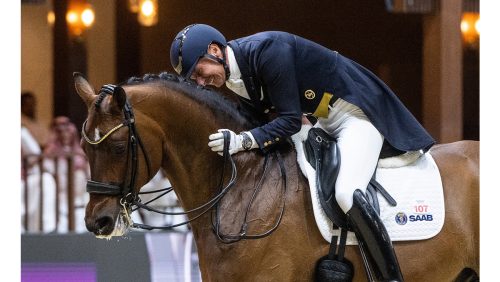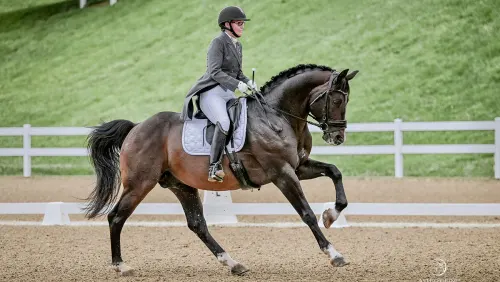In his first installment, our columnist believes elementary-level trainers deserve much more credit for the solid foundation they provide the sport.
One of the things I love best about teaching is that, on an almost daily basis, you can reconnect with the people from the past who made you the instructor you are today.
When you’re teaching, how often do you say something, give an explanation or search your brain for a better way to get a point across, until suddenly, in a moment of inspiration, you remember some tidbit you learned from one of your teachers of long ago? More often than not, I can clearly remember the day, the expression on his or her face and the tone of voice that conveyed it.
When this recollection happens to me, I always smile, take a moment to enjoy the memory and silently thank the teacher who shared that particular bit of wisdom with me. Perhaps I’m fortunate in that I’ve had more than my share of great instructors over the years.
Sometimes I worry about whether those great instructors are still around, but of course they are. We see them at the U.S. Dressage Federation Symposiums and Trainers’ Conferences.
The High Performance riders are exposed to them through the U.S. Equestrian Federation’s Elite and Developing Rider clinics, and many local dressage associations have them for their own symposiums.
But when you’re teaching and suddenly think of an exercise or an explanation that better illustrates the idea you’re addressing, more often than not, it isn’t a big-name instructor who planted that information in your memory bank. Out of the blue, you see the image or hear the voice of a teacher you had prior to being exposed to the celebrity instructor.
Our first instructors probably leave the most lasting impressions on our careers, and, in many ways, also on our lives. I believe that we all too frequently underestimate the importance of those teachers who introduced us to our sport.
Riding requires an automatic partnership between horse and rider—along with the physical and athletic skills needed, we must also learn about fairness and the ethical treatment of our horses. Frequently we learn our respect for the horse as an animal, as an individual and as our partner early on in our riding.
Although most of us mellow over time and become more patient as we develop better skills and knowledge, it’s hard to change our core values and attitudes once they’re established, so the proper attitude should be instilled from the beginning. Those first instruc-tors plant the seeds of our values, which carry on throughout our lives.
It seems, in the dressage discipline at least, that riding schools have fallen victim to economics and modern society. Amid increased liability concerns (and therefore rising insurance costs), feed and bedding prices, labor, and, until recently, real estate values, it’s been difficult to run a riding school lesson program as a viable business.
ADVERTISEMENT
Where will people of all ages initially go to pursue a dream of learning how to ride? It’s a mystery to me how we attract greater participation in our sport when we don’t provide entry-level opportunities. I have a lot of respect for those who’ve kept their lesson programs going given all the challenges.
The Power Of A Planted Seed
The good first instructors are truly the unsung heroes of our sport. There isn’t much glamour in teaching at the elementary level, whether it’s up-down lessons or riders who’ve climbed up to the next rung. Yet these instructors can have a major impact on the present and future of our sport.
Whether I’m doing a junior/young rider clinic or teaching adult amateurs, I truly appreciate a student with good basics and a solid foundation. Of course, my pet peeve is working with professionals who are missing some of the basics. No one enjoys being surprised by find-ing holes and then trying to fill in those holes. It’s much easier when a good foundation is there, and we can communicate in the same language.
Whenever I doubt the power a teacher can have, I just remember some of the instances where they’ve had a major impact in my life. We all know of examples of when they’ve sparked interest and even lifelong dedication to a certain topic. And, unfortunately, most of us know of times where they’ve killed an interest in a subject.
Both my parents were sculptors, so imagine my devastation when I discovered that my daughter, who loved to do artwork, no longer draws or paints because a high school teacher discouraged her. It usually boils down to just a couple of words or an attitude, and it sticks with us for life.
When I was young, my father told me, “It’s the teacher’s fault when the student doesn’t learn.” That’s a philosophy I try to follow. Of course, when I’m not successful at reaching a student, I admit I feel a little better when I remember my father was not a teacher by profession!
Teaching has its own skill set. Some-times we assume when someone is a top competitor, trainer or judge that he can automatically teach, but there are times when this just isn’t true.
In dressage, our system of training judges recognizes this fact. Even the most successful international riders who want to judge have to start at the bottom and work their way up like everyone else. The good judges study judg-ing the way a good rider studies riding. Even the most naturally gifted teachers do the same thing even if they’re not always aware of the time and thought they put into learning their trade.
As a culture we tend to undervalue our elementary teachers, while we frequently hold our professors in high esteem. This isn’t necessarily backwards, but in the big picture it doesn’t make sense. The critical impact that the elementary teacher has is often greater than that of the college professor.
Planning And Promoting
ADVERTISEMENT
In 2000, The Dressage Foundation, in a joint effort with the USDF, conducted interviews with approximately 40 U.S. dressage leaders as part of what became known as the Vision Project. Along with John Boomer, I was fortunate to be one of the interviewers.
I distinctly remember Scott Hassler lamenting about the lack of trainers for young horses in this country and how being a young horse trainer is not considered a viable profession in the United States. It’s not prestigious enough here. It seems our young riders all aspire only to the lofty goal of the Olympic Games, but in Europe young people consider being a young horse trainer a respected career option. Of course, over there it carries quite a bit of prestige; Dr. Ulf Möller and Hans Peter Minderhoud are excellent cases in point.
A decade later, Scott and his group have made some significant inroads, and you see more and more professionals proud to be known as young horse trainers.
I’ve written before that one thing became evident during the year we USDF leaders spent publicly discussing the Riders Standards Proposal: if we want to improve riding standards in this country, we must look at it from three vantage points—judges, riders and coaches/instructors.
Discussion is underway regarding judges, as there’s also a real possibility of a riders test as requested by the USDF members attending the USEF Committee Open Forum during the 2008 USDF Annual Meeting. Now we should apply a focus on our instructors that’s similar to what we’ve had on our young horse trainers.
Our organizations need to keep this critical group in mind as we move forward. From the High Performance end, we’ve discussed the possibility of a pipe-line for riders, starting at FEI Ponies through Juniors, Young Riders, Brentina Cup and on to the senior international ranks.
However, any viable discussion of this pipeline must include a process by which we can identify the successful and prolific instructors of those riders who are just entering and starting up the road. Once identified, we need to target those instructors and coaches and provide them access to clinics, seminars and other educational opportunities.
From the USDF angle, we also need to identify and provide continuing educational opportunities to those instructors who are working at an elementary level. That might mean encouraging group member organizations to offer educational opportunities or doing more outreach on a national level through USDF-run programs.
Lastly, we need to create an environment where professionals of all levels are recognized for achievements that are above and beyond the ordinary. There are several ways this could be done. Instructors could be rewarded for the success of their students, or trainers could have a “professionals only” class where they compete against each other at a regional level. Or perhaps we could offer a Teacher Of The Year award. Through recognition in these areas, we could encourage others to seek out further education so they, too, can be the best at what they do.
The sport of dressage needs to attract new people to the elementary levels, give them incentives to advance by recognizing their achievements and provide continuing educational opportunities. In the end, whether you’re a junior or an adult, everyone gains through our commitment to quality teaching, and that means giving these instructors the glory they’re due. Anything short of this, and we’ll be letting our horses down.
George Williams is the president of the U.S. Dressage Federation and has served on and chaired numerous committees for the USDF and the U.S. Equestrian Federation. A rider, trainer and coach, training for Havensafe Farm in Middlefield, Ohio, and Wellington, Fla., Williams earned national and international fame with several Grand Prix mounts, including the Chronicle’s 2003 Dressage Horse of the Year, Rocher. He began writing Between Rounds columns in 2010.















